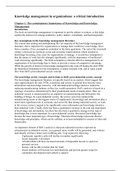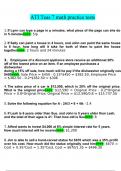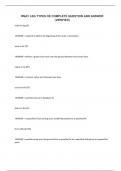C6: GENDER AT THE INTERSECTIONS
Learning Objectives
1. Students will be able to understand the difference between sex and gender.
2. Discuss the relationship between gender and three major institutions: sports, work, and politics
3. Describe feminism and the three major waves of the feminist movement.
4. Understand and be able to apply the concept of intersectionality.
5. Assess the role sexuality in society and the importance of key early studies of sexuality.
6. Explain the concepts of homophobia and heteronormativity and their importance for larger issues
of inequality.
Sex and Gender
● Sex: biological identity and can be divided into the main categories of male and female.
● Gender: social concept referring to the entire array of social patterns associated w/ men and women
in society.
Sex vs Gender - What’s the difference?
● Similar to difference b/w race and ethnicity
○ Sex is based on perceived biological differences (physical)
○ Gender is rooted in social and cultural constructions and distinctions (internal-social)
● Physical differences DO NOT explain gender-based social disparities
○ The way we expect men and women to act (“masculine” & “feminine” behaviour) is socially
constructed
● There are problems of thinking of sex as dichotomy (only as male and female)
Conceptions of Sex and Gender
● Middlesex Categories: some societies are composed of 3 genders - men, women, and a third group
that is variously named. (e.g; biological males who perform social roles of women “male women”,
South African and American-Indian societies have “manly hearted women” - women who perform
social role of men)
● Intersex People: individuals born w/ sexual organs of both sexes; can be trans (challenges our binary
ideas of gender).
● Transgender Umbrella: term used to encompass the variety of sexual expressions in modern society.
○ Transgender: someone who does not identify with his or her sex assigned at birth.
○ Two-spirit: someone who fills one of the many mixed-gender roles prevalent in Native
American communities.
○ Multi-gender: someone who identifies with more than one gender (E.g; bigender).
○ Genderfluid: someone whose gender changes.
○ Agender: someone who does not identify with a gender.
○ Genderqueer: someone who does not identify within the gender binary.
○ Cis-gender: someone who is not trans.
Gender as a Social Construction
Social Construction
● Social construction is a two step process:
○ Classifying experiences (acting on the basis of these categories)
○ Forgetting that we have created divisions (see them as unchangeable and natural)
● We categorise people to help us understand how we should interact w/ them
Gender as a Social Construction
● Some people choose not to identify w/ a particular sex or raise children w/ such an identity
● Learning, understanding and viewing one another as male/female are social processes
● Children learn about these expected behaviours via social processes by:
○ Parents (have certain ideas about gender-appropriate behaviour)
, C6: GENDER AT THE INTERSECTIONS
○ Schools (children learn to perform gender through socialisation - social institutions support
and perpetuate gender appropriate behaviours)
○ Same-sex social circles (expected behaviour is reinforced in same-sex social circles at the
stage when boys only play w/ boys and girls only play w/ girls)
○ Media
○ Further Life (process continues throughout our life e.g; workplace, familial roles etc)
Gender Roles
● Gender Roles: one set of roles that we perform in society.
● Gender is situationally constructed through individual’s performances
○ Dramaturgical Perspective: seeing social life as a stage and individuals are actors portraying
roles. (Erving Goffman)
○ We are actors on the stage of life performing our gender through clothes, mannerisms, and
behaviours
○ 2 stages (on which we “perform”):
■ Front Stage: public setting so we try to make a positive impression on others (in this
case living up to the expected gender norms)
■ Backstage: private setting so we do not feel the need to make a positive impression
(in this case we reveal a different set of gender displays)
● Costs of Masculinity - Michael Messner (1997)
○ Costs of Masculinity: while we often focus on the costs of being female, our society also
have very restrictive idea of what is means to be a man.
○ There are many social costs to displaying gender in ways that our society deems
inappropriate
○ Outlines rules of masculinity such as:
■ Men must avoid anything feminine (e.g, romantic comedies, ballet)
■ Masculinity is defined by external success (e.g; money, fast cars, jobs)
■ Men are expected to show little emotion and be aggressive
○ These rules of behaviour are limiting for men
○ Men are sanctioned for stepping outside of these norms
■ Men who perform jobs that are considered feminine have to deal w/ their
masculinity being questioned
■ Men who break the rules might be degraded and lessened to the status of a woman
■ If a man fails to live up to gender norms it may be insinuated that he is like a woman
or a homosexual and therefore inferior
● Gender Trouble - Judith Butler (1990)
○ Arguement #1: all gender is created and sustained through performances and we create
gender through our actions and interaction
■ Performativity: “not a singular act, but a repetition and a ritual.”
■ What we take to be an “internal essence of gender is manufactured through a
sustained set of acts, posited through the gendered stylisation of the body”
■ What we take to be an “internal feature of ourselves is one that we anticipate and
produce through certaion bodily acts”
○ Argument #2: labelling a person as male or female is overly restrictive (e.g; person defined
as male is supposed to possess masculine and heterosexual traits such as being sexually
active, aggressive, attracted to females etc)
■ Characteristics are exhibited as a performance BUT not necessarily voluntary
■ Some men might naturally want to behave this way but others might find that this
behaviour does not reflect their sense of self
■ THUS gender does not automatically stem from inherent personality characteristics
but is the result of cultural norms and practices that are reinforced
■ Concepts of masculine and feminine are just as natural as the sex that they are
attached to
■ Deviations (e.g; homosexuality) are marginalised as being outside of “normality”











